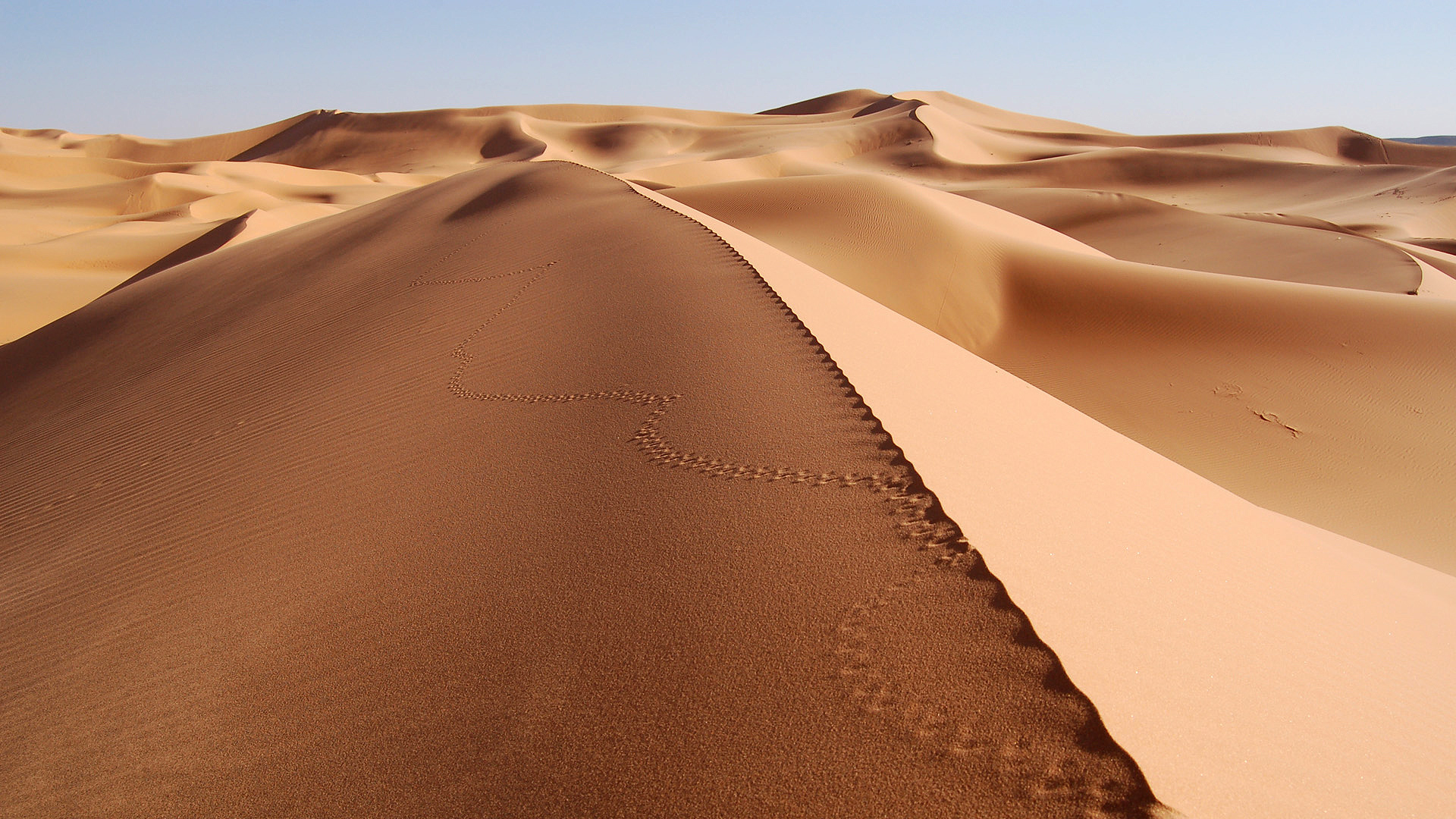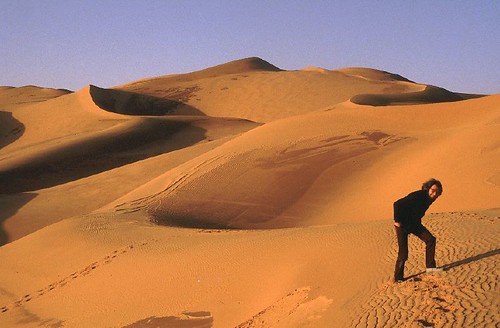Team members
Names / Roles:

- [Tan Yi Zhen] (Researcher)

- [Teo Yu Xiang] (Wiki Writer)


Overview
There are a lot of deserts all over the world.

Examples in Africa:
- Algerian Desert – part of the Sahara located in Algeria

- Blue Desert – a desert in Egypt
- Kalahari Desert – a desert covering much of Botswana and parts of Namibia and South Africa
Examples in Asia:
- Gobi – a desert in Mongolia and China

- Dasht-e Lut – a large salt desert in southeastern Iran
- Wahiba Sands – a desert in Oman
Examples of a Cold Desert:

And a Hot Desert:

The deserts are regions of the ecosystem that is covered with sand, snow or ice. The hot deserts covered with sand usually do not have a lot of rainfall throughout the year.
Most organisms could not live or grow in both the hot and cold deserts because it is either too hot or cold for them.
Physical Factors
The amount of light the deserts receives is 21 hours, with only 3 hours of the sun not shining.

Deserts can be classified as "hot" or "cold". Cold deserts can be covered in either snopw or ice. The frozen water makes it so that most plants could not grow and nurture there. The cold deserts are commonly known as tundra if a short season of above-freezing temperature is expirienced, or an ice cap, if not. Hot and Dry Deserts temperature ranges from 20 to 25° C.The extreme maximum temperature for Hot Desert ranges from 43.5 to 49° C.Cold Deserts temperature in winter ranges from -2 to 4° C and in the summer 21 to 26° C a year. (Picture are in the Overview)
It is a place that receives an extremely low amount of rainfall, less than enough for plants to grow and nuture there. Most deserts have an average annual precipitation of less than 400 millilitres. Deserts lose more water than they receive. Deserts can be described as regions where water is lost by evaporation and transpiration than falls as precipitation.

The air in the dry and hot deserts is very heavy because of the heat and the humidity is very low. The air in the cold deserts are cold.
The pH level of the soil of the deserts are 23, which makes it not acidic.
Classification of Living Organisms
Producers
-Cacti, Sagebrush

 This producers holds the most amount of nutriant level and obtain it's food through the sun . There are not alot of spieces of producers in the desert as the condition and weather is harsh . Those plants which are able to adapt to the harsh conditions possess special structures or behaviours . etc , The cactis have special leafs which appear to look like needles , this unusal leafs not only keep the plant - eaters away but also minimise the amount of water lost .
This producers holds the most amount of nutriant level and obtain it's food through the sun . There are not alot of spieces of producers in the desert as the condition and weather is harsh . Those plants which are able to adapt to the harsh conditions possess special structures or behaviours . etc , The cactis have special leafs which appear to look like needles , this unusal leafs not only keep the plant - eaters away but also minimise the amount of water lost .
Primary Consumers
Rats
 Rats are typically distinguished from mice by their size; rats are generally large muroid rodents, while mice are generally small muroid rodents which feaste on crumbs , left overs or plants found in the deserts . This rodents are fast on their feets thus minimising the contact with the hot sand .
Rats are typically distinguished from mice by their size; rats are generally large muroid rodents, while mice are generally small muroid rodents which feaste on crumbs , left overs or plants found in the deserts . This rodents are fast on their feets thus minimising the contact with the hot sand .
Secondary Consumers
Tarantulas,Snakes
 Tarantulas (as the term is used in North America) comprise a group of often hairy and often very large arachnids belonging to the family Theraphosidae, of which approximately 900 species have been identified.
Tarantulas (as the term is used in North America) comprise a group of often hairy and often very large arachnids belonging to the family Theraphosidae, of which approximately 900 species have been identified.
 Snakes are legless reptiles which teeth's sometime contains venom which are used to either injured or kill it's preys . Most snakes are carnivores they they mainly eat rats or birds . However , the snake's jaws is a complax structure , the upper and lower jaw are separated allowing to swallow a prey much bigger than it is .
Snakes are legless reptiles which teeth's sometime contains venom which are used to either injured or kill it's preys . Most snakes are carnivores they they mainly eat rats or birds . However , the snake's jaws is a complax structure , the upper and lower jaw are separated allowing to swallow a prey much bigger than it is .
Tertiary Consumers
Coyotes,Hawks
 The coyotes's diet are based on the seasons , they have a 90% mammalian diet and are carnivores somewhere at the top of the food chain . They eat animals like voles , prairie dogs , eastern cottentails , squirrels mice , birds or even the people's lifestocks . Birds with nestes build on the ground are often targeted by them as they are easier to catch .
The coyotes's diet are based on the seasons , they have a 90% mammalian diet and are carnivores somewhere at the top of the food chain . They eat animals like voles , prairie dogs , eastern cottentails , squirrels mice , birds or even the people's lifestocks . Birds with nestes build on the ground are often targeted by them as they are easier to catch .
 Hawks were named among the most intelligent birds in the world , they have sharp eyes and sharp beaks like that of an eagle's . They eat small creatures like mice , rabbits or smaller birds . The hawk have sharp pointed nails on its feet to grap and tear the prey apart .
Hawks were named among the most intelligent birds in the world , they have sharp eyes and sharp beaks like that of an eagle's . They eat small creatures like mice , rabbits or smaller birds . The hawk have sharp pointed nails on its feet to grap and tear the prey apart .
Decomposers
Dung beetle
 The dung beetles are the decomposers of the ecosystem , they help get rid of the animal's waste , they can be found in many places like farmlands and deserts .The dung beetles have a unique choice of location to lay their eggs and eating , it would first roll the animal feaces up into a ball before eating it or it might lay its eggs in it so that it's young can have an immideat supply of food when they hatch . This is also a good way of hiding the eggs as other animals which eats their eggs might think that the feaces have nothing inside and leave it alone .
The dung beetles are the decomposers of the ecosystem , they help get rid of the animal's waste , they can be found in many places like farmlands and deserts .The dung beetles have a unique choice of location to lay their eggs and eating , it would first roll the animal feaces up into a ball before eating it or it might lay its eggs in it so that it's young can have an immideat supply of food when they hatch . This is also a good way of hiding the eggs as other animals which eats their eggs might think that the feaces have nothing inside and leave it alone .
Food Web
A food web of the deserts

Interrelationship in Ecosystem
Give at least one example for each of the following relationships in the ecosystem:
- Predator-prey relationship
The desert snake would be hunting down on the desert rat for food. The snake is the predator and the rat is the prey. This way , the rats get eaten and the predator - prey relationship ends .

The fleas on the kangaroo rat would benefit sucking the blood of the rat for food while the rat would die if the rat loses too much blood . This way , the rat would suffer lose while the fleas gain survival .

Bees would benefit from getting nectar from the cacti flowers while the cacti benefits from able to get its pollens stuck onto the the bee's legs and help pollunate other cactis. This way both party wins .

Useful Links
Plagiarism is a strongly discouraged.
Include the links of all websites you obtained information from to complete your ecology wiki.
For example:
Wild World @ nationalgeographic.com ( http://www.nationalgeographic.com/wildworld/terrestrial.html )
Comments (4)
Mr Justin Thong said
at 4:50 pm on Mar 14, 2012
Dear group 8, a gentle reminder that the deadline is this Friday. From the look of it, your group is still far from completion and I do not see much progress. Is everything ok?
1E1_2012 Group 8 said
at 6:31 pm on Mar 14, 2012
Dear Mr Thong, I'm sorry we are progressing so slowly, we currently have a little issue of 2 people going for camp, a editor and a researcher. We are currently trying to catch, please be a little more patient with us
-Wei Xin
1E1_2012 Group 8 said
at 7:58 pm on Mar 14, 2012
Dear Mr Thong, is this acceptable? with only a few parts missing, we will be able to finish it by tomorrow :D
-Wei Xin
1E1_2012 Group 8 said
at 4:05 pm on Mar 20, 2012
Dear Mr Thong , I am please to inform you that we are some what done already can i trouble you to help us run a check to see if we can make any improvements or changes ? Also if theres any missing details or facts .
Yours sincerly ,
Don Lee
You don't have permission to comment on this page.